Below is showcased projects across 18 categories ranging from Heritage to Health and Wellbeing, Community and Faith to Infrastructure and Transport.
All projects in this year’s awards were completed between January 2021 and July 2022. Key to the process is that every shortlisted building is visited by judges and rigorously assessed across a wide range of criteria. This has included design quality: from use of materials and detailing to spatial ‘delight’, build quality, programme, user experience and contribution to neighbourhood. In addition, sustainability and building performance have been key to the assessment: including evaluation of whole-life carbon principles, operational energy use or flexibility and adaptability.
The expert judges, who visited every shortlisted scheme over the summer, included Kirsten Lees of Grimshaw, Biba Dow of Dow Jones and engineer Webb Yates co-founder Steve Webb. Also on the judging panel were Sumita Singha, Daisy Froud and former AJ architecture editor Laura Mark.
In addition to stand-out design, the judges will consider how each project has met or exceeded its brief, how it has promoted client or community engagement and how it has excelled in the use of space or sense of place. They will also analyse what sustainability measures have been put in place.
The winners were announced at a special gala event at the Hilton Metropole, London on 23 November 2022, hosted by writer and radio presenter Richard Coles.
In addition to the category winners below, The AJ Architecture Awards also included three special prizes drawn from the other category winners and chosen by the AJ editorial team to honour exceptional projects and practices. The Editor’s Choice award went to a London social housing scheme by Archio; Design of the Year was given to Heyningen and Haward Architects’ Houlton School; and the 2022 Practice of the Year was FaulknerBrowns.
The winner of The Manser Medal and AJ House of the Year, honouring the best in domestic design, was also announced on the night.
Project under £500,000
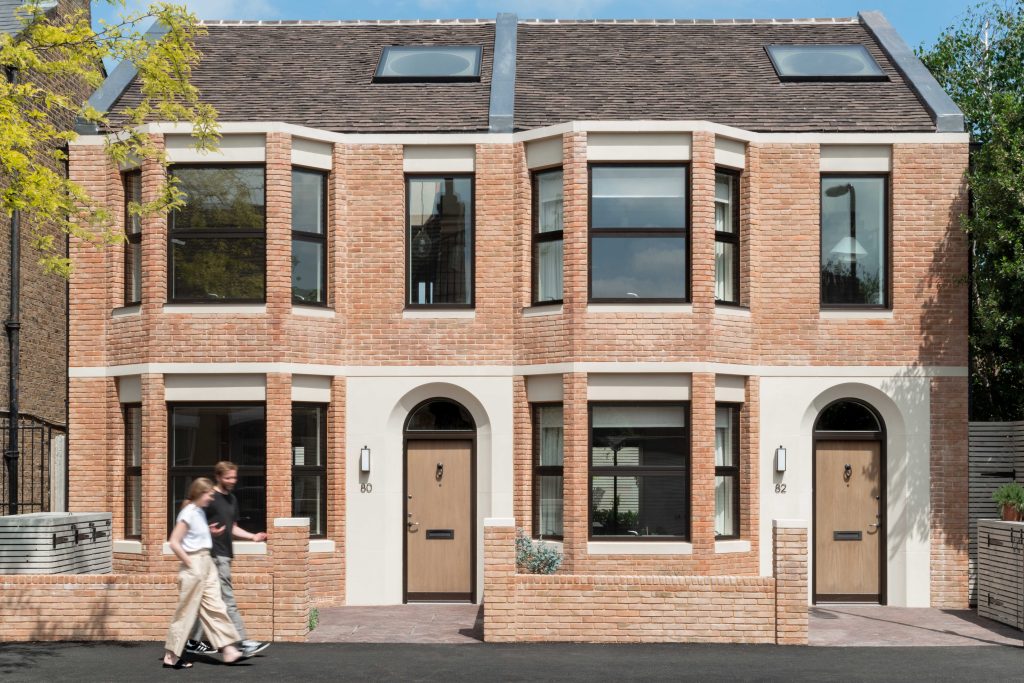
Photograph by FRENCH+TYE
Leybourne Road by Nelson Wright Architects
The judges described the winning scheme of the under £500,000 category as ‘a refreshing take on a terraced family home that has wide appeal to the market’ and an excellent example of architects ‘punching above their weight’.
The judges admired this project’s dialogue with its context, praising the houses’ contextual exteriors and citing the generous thresholds and front door surrounds, bay windows and pitched roofs as recognisable elements that relate well to the street, despite their contemporary detailing. While the judges acknowledged that the infill scheme’s plan was not ‘ground-breaking’, they described it as ‘very well executed’, with clever use of sliding doors and joinery. ‘It makes friends with its neighbours and would be pleasing to walk by,’ they said.
While the shortlist included several strong schemes, the Leyton Road houses stood out as the winner in this category because they demonstrate that architects can do more than create beautiful places – they can deliver value and address wider societal issues, in this case the housing crisis. The architects deployed their skill to exploit the site to its fullest potential. This entrepreneurial approach of building two terraced houses to finance one is an example that can be replicated.
‘This is the type of work we as architects should be doing. We can’t just be architects any more; we must ask ourselves where we fit in the industry. There is a burgeoning desire to do more and this project exemplifies that approach,’ concluded one judge. HH
Location London E11 • Completion March 2022 • Construction cost £480,000 • Gross internal floor area 240m2 • Client Nelson Wright Architects • Structural engineer Nelson Wright Architects • Services engineer N/A • Main contractor N/A • Annual carbon emissions Not supplied
Highly commended
Ferrings by Williams Griffiths Architects
The judges described this project as ‘cunning and clever without making a statement.’ The extension revitalises a period house without compromising the original design through a subtle reorganisation of the plan, introduction of a delicate brick screen wall at the street and thoughtful interior moves, such as raised door heads and new joinery. An exemplar of intelligent re-use. HH
Cultural
Sponsored by WSP
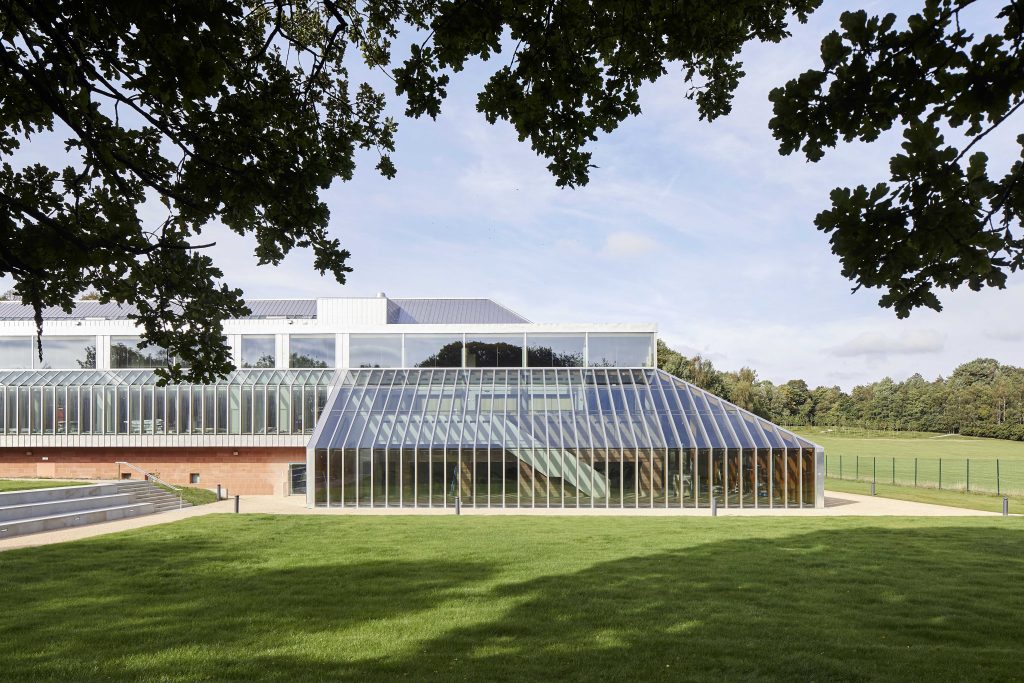
Photograph by Hufton + Crow
The Burrell Collection by John McAslan + Partners
‘A sophisticated, sensitive, seamless refurbishment,’ enthused the judges about John McAslan + Partners’ winning renovation of this much-loved museum, which has revitalised the building without sacrificing its original character.
In recent years the Category A-listed Scottish building had become unfit for purpose, due to water ingress, poor energy performance and issues with access and flexibility.
Internally, key areas have been opened up, improving horizontal and vertical movement and creating an additional 35 per cent of display space. This gives access to a much greater range of the collection. A redundant lecture theatre was replaced with a triple-height central orientation hub, with stairs connecting the mezzanine galleries to the new viewable art stores, exhibition and events spaces. The new scheme has added a more accessible second entrance to the east, accessed through a paved piazza.
The landscape design looked to enhance the original design’s intersection with the woodland, providing new spaces for socialising and relaxation, including a café terrace and amphitheatre.
Through collaborative design with Atelier Ten and Arup, the Burrell has been adapted and refurbished under a ‘fabric first’ approach, which will save more than 600 tonnes of CO2 per annum by improving airtightness, reducing energy demand and improving environmental controls. Most of the existing materials were recycled or re-used.
Working with Glasgow City Council’s project education and outreach officer, McAslan engaged with local schools and community groups to increase awareness of the building and its collection and to develop a more inclusive and relevant outreach strategy. ‘You really want to go back, and it’s really successful in terms of its sustainability,’ said the judges, who also praised the project’s ‘amazing’ client. ‘Now it’s a place that you go to experience the history around the collection.’ EB
Location Glasgow • Completion March 2022 • Construction cost £30 million • Gross internal floor area 14,430m2 • Client Glasgow Life • Engineer David Narro Associates • Services engineer Atelier Ten • Main contractor Kier • Annual carbon emissions 126 kgCO2/m2
Heritage
Sponsored by AG Paving & Landscaping

Photograph by Hufton + Crow
The Burrell Collection by John McAslan + Partners
The Burrell Collection is one of Europe’s finest museums, housing more than 9,000 works of art amassed by Glaswegian shipping magnate William Burrell. Since 1983 it has occupied one of Scotland’s very few Category A-listed post-war buildings, originally designed, to great acclaim, by Barry Gasson, Brit Andresen and John Meunier. In recent years, however, the building was blighted by leaks, poor energy performance and issues around accessibility and flexibility, reflected in declining visitor numbers.
The remodelling by John McAslan + Partners focused on repairing failing fabric, improving environmental performance, adapting the interior to meet visitor needs and enhancing connections to the surrounding Pollok Country Park. The scheme’s architectural character was defined by the original building and considerable effort and ingenuity were expended to preserve it, while making it fit for purpose once more.
The judges were especially impressed by how a ‘fabric first’ approach rigorously underpinned the project. By restoring weathertightness, reducing energy demand and implementing more sophisticated environmental controls, a BREEAM ‘Excellent’ rating was achieved, a rare feat for a building of this age. Existing materials were either recycled or re-used, including the aluminium glazing frames.
A new secondary entrance rationalises access, leading straight into the heart of the museum, where a central staircase enables visitors to explore all three floors, including the lower-ground art stores. Display space has been increased by 35 per cent, supporting a new thematic curatorial strategy and multi-media displays.
Feedback from local people shaped every aspect of the building’s remodelling and was key in helping to devise a compelling new visitor experience. CS
Location Glasgow • Completion March 2022 • Construction cost £30 million • Gross internal floor area 14,430m2 • Client Glasgow Life • Engineer David Narro Associates • Services engineer Atelier Ten • Main contractor Kier • Annual carbon emissions 126 kgCO2/m2
Landscape and Public Realm
Sponsored by Marshalls

Photograph by Keith Hunter
The Bowline at Bowling Harbour by rankinfraser landscape architecture
Rankinfraser’s Bowline in West Dunbartonshire takes inspiration from New York’s High Line to transform a disused Category B-listed railway viaduct into a state-of-the-art linear park and sustainable transport route.
The Bowline, part of a wider £10 million regeneration programme at Bowling Harbour, connects the Forth & Clyde Canal towpath to the wider National Cycle Network, providing virtually uninterrupted walking, wheelchair and cycling access from Glasgow to Loch Lomond and The Trossachs National Park. Making use of what was already there in terms of both infrastructure and natural features, the scheme has rejuvenated the derelict steel viaduct and swing bridge and converted railway arches into new business space while pioneering the use of canal dredgings, which are usually classified as waste and disposed of in landfill or at sea, as a source of topsoil.
The concept for the regeneration project, which has emerged since 2014, when a masterplan was developed by various stakeholders, was heavily community-orientated and rankinfraser employed a Scottish Government-sponsored design charrette to ensure a shared vision emerged.
While they said the project was not flawless, judges praised the Bowline as a beautifully designed and delivered scheme which prioritised sustainability and made the most of the existing place with a ‘crisp architectural style’.
‘It really springs from something that already exists,’ said one. Another remarked: ‘It successfully elevates the experience of a cycle path. It’s an incredible design challenge to integrate the canal, the railway line and the road and it does that seamlessly. It really makes the soul sing.’ WH
Location Bowling, West Dunbartonshire • Completion September 2021 • Construction cost £6 million • Gross area 10,000m2 • Client Scottish Canals • Engineer Blyth & Blyth • Services engineer Blyth & Blyth • Main contractor Mackenzie Construction • Annual carbon emissions Not supplied
Highly commended
Valley Gardens by Untitled Practice
The AJAA judges were keen to recognise this Brighton project, which they said delivered a massive amount on a small budget. The scheme, for an important 1.5km-long city centre site between St Peter’s Church and the famous Royal Pavilion, reconfigures a landscape dominated by cars to release public realm for pedestrian and cycle use. It also prioritises biodiversity through the planting of 140 new trees and extensive perennial-planted gardens. ‘The overall impact and scale of this project is huge. It’s a project of exceptional value to the user and to the city,’ one judge said. WH
Leisure

Photograph by Hufton + Crow
F51 Sports Park by Hollaway Studio
The Leisure shortlist sparked a heated debate among the judges, who were concerned that reduction of embodied carbon ‘was not taken seriously enough’ in any of the schemes. However, two projects stood out for their transformative social agendas.
Holloway Studio’s F51 Sports Park in Folkestone wowed the judges for its expressive architecture and as a building that brings ‘hope and joy to a deprived community and provides the seed of something greater’, despite its extensive use of concrete, steel and aluminium. The facility ‘embodies the edginess of skateboarding and expresses what’s happening inside’, said one judge. It creates ‘a nest, a protected environment where you can be yourself and be as loud as you want,’ noted another. As a magnet and a haven for skateboarders, the Sport Park contributes to building community in a disenfranchised area of Folkestone, with £1 entry offered to local primary school pupils. It also provides Olympic-quality facilities, enabling athletes to train for global competitions.
In terms of the building’s embodied carbon, the judges queried the thickness of the lowest concrete skateboarding bowl (the two upper bowls are made of timber), the narrow spacing of oversized concrete columns, and the choice of aluminium for the cladding.
Nevertheless, the F51 Sports Park is a deserving winner, because it demonstrates how architects can use their agency to build social capital and create opportunities in a diverse community. HH
Location Folkestone • Completion April 2022 • Construction cost £17 million • Gross internal floor area 3,250m2 • Client The Sports Trust, The Roger De Haan Charitable Trust • Engineer Ramboll • Services engineer Atelier Ten • Main contractor Jenner Group • Annual carbon emissions Not supplied
Highly commended
Britannia Leisure Centre by FaulknerBrowns
The judges described the Britannia Leisure Centre as ‘bold and expressive, with a complex programme that can be adapted to a wide range of uses and user groups’. Simple techniques, such as colour strategies and way-finding, ensure that the building is inclusive for all. The building deals ‘eloquently with a wide range of physical, social and cognitive challenges, including the nuances of cultural diversity, such as different beliefs and behaviours,’ said the judges. HH
Community and Faith

Photograph by Hufton + Crow
Bath Abbey Footprint Project by Feilden Clegg Bradley Studios
This decade-long project to repair and future-proof the Grade I-listed Bath Abbey wowed the judges with its exceptional craft, thoughtfulness and ingenuity in how to reduce the energy use of an historic building.
Led by a dedicated Feilden Clegg Bradley Studios team, the £19.3 million in total programme focused on the conservation and re-laying of the historic floor, with its roughly 3,000 stones. Below this, the practice introduced a low-carbon underfloor heating system using waste heat from the city’s natural thermal springs. According to the architect, the main objectives of the project were to open up the abbey and give the building ‘a further 100 years of life, before the next major repair work will be required’.
As well as re-modelling the interior of the abbey, the practice also created new learning and music spaces, such as a bespoke rehearsal studio for the 60-strong choir, in the once-damp Georgian and Victorian basement beneath the pavements of Kingston Parade.
The judges described the scheme as ‘simply knockout’ and an exemplar of ‘how a 1,000-year-old building can become a pioneer for a new, sustainable future, both in this century and the next.’
They added: ‘It is a highly successful labour of love, carried out over 10 years, which has made this historic listed building truly accessible and sustainable.
‘A technically complex scheme, with meticulous attention paid to every detail, the quality of work is outstanding. There is no ego here. It is a flexible and inventive solution, literally tapping into Bath’s natural hot spring water, which will undoubtedly stand the test of time.’ RW
Location Bath • Completion December 2021 • Construction cost £10 million • Gross internal floor area 3,294m2 • Client Bath Abbey • Engineer Mann Williams • Services engineer Buro Happold • Main contractor Emery Contractors • Annual carbon emissions Not supplied
Highly commended
Jubilee Pool by ScottWhitbyStudio
The jury also wished to recognise the community-driven revamp of the decaying 1935 Jubilee Pool in Penzance, in particular the ‘ripple effect, in terms of social impact, which went way beyond the lido itself’. The judges said: ‘The rejuvenation of the closure-threatened Art Deco pool, through a careful process of preservation and sensitive contemporary additions, into a year-round destination has given Penzance a huge boost – not least to its civic pride. This is a success story of how local activism, combined with judicious architectural interventions, has created something special and memorable. Everyone should visit it.’ RW
Civic

Photograph by Hufton + Crow
Sunderland City Hall by FaulknerBrowns Architects
Judges said they were surprised at how ‘truly civic’ this building felt, given it sits in the middle of a £500 million regeneration scheme on the former Vaux brewery site.
Designed as an early-stage catalyst aiming to unlock Sunderland’s deprived urban centre, the building combines public and private uses, including office space, for Sunderland City Council. All is arranged in navigable, open floorplates around a light-filled atrium to facilitate visual connections and encourage collaboration. An entirely publicly accessible ground floor includes an untypically multifunctional council chamber, customer service centre with free-to-use computers and a café, giving the space the flexibility to switch function as users require.
At the centre of the atrium is a red oxide steel staircase inspired by the city’s rich history of industrial craftsmanship. The stair, the steel for which was locally sourced and fabricated by shipbuilders, creates a sculptural centrepiece to the building.
The façade, formed of civic-scaled columns and large, glazed openings to promote transparency, has been designed to respond to its orientation and takes advantage of its site in a way which the judges said reminded them of buildings by celebrated Spanish architect Rafael Moneo.
‘Open, uplifting, moving and intuitive’ were all words used by the judges, as well as ‘sophisticated but not shouty’. ‘It does everything right,’ they said, praising the level of thought and detail and the collaborative, forward-thinking client. FW
Location Sunderland • Completion November 2021 • Construction cost £42 million • Gross internal floor area 17,900m2 • Client Sunderland City Council • Engineer Cundall • Services engineer Desco • Main contractor Bowmer + Kirkland • Annual carbon emissions Not supplied
Refurb
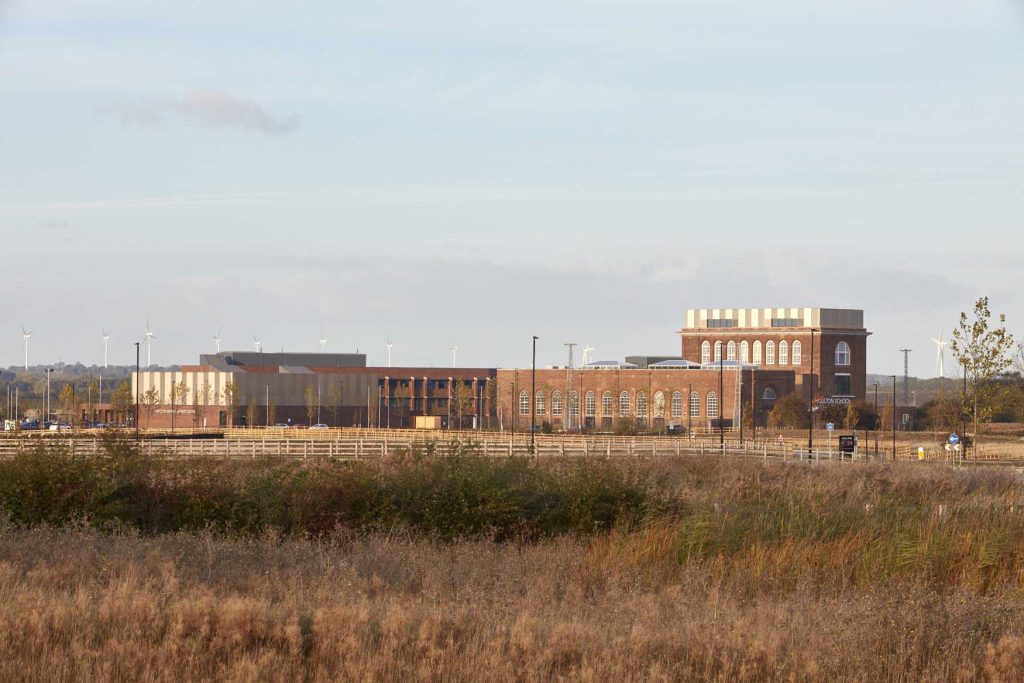
Photograph by James Brittain
Houlton School by van Heyningen and Haward Architects
This project sees the listed remains of the historic Rugby Radio Station cleverly transformed into a new 6FE secondary school and sixth form. It is designed as an anchor point for the emerging mini-town of Houlton – a planned residential district that will eventually provide 6,000 homes. Delivered by developer Urban&Civic, working with the Department for Education and expert school designers van Heyningen and Haward, creative adaption and sustainable retrofit of the Grade II-listed former transmitter building, C Station, is combined with three new blocks.
The team’s priority from the outset was getting the environmental aspects of the project right – to future-proof the school, maximising the quality of the building’s envelope and services and minimising operational energy, costs and life-cycle carbon. The new blocks have been designed to close to Passivhaus standards, while restoration and insulation of the historic façades and replacing historic windows have balanced the impacts of conversion to lift the building’s performance drastically. The judges were impressed by how, with a tricky brief, the whole team had challenged both themselves and the DfE to produce a school complex that is both ‘sensitive’ and ‘inspiring’.
The entrance sequence – formed of a series of archways as fragments of the existing – creates a lovely exterior space to be in, they added. Retaining and salvaging as much as possible, the architects used contrasting brick to patch in the existing fabric.
Overall, the judges thought this was a ‘surprising’ and ‘beautiful’ project that really challenged the brief to produce something clever that keeps the story of Rugby Radio Station going for future generations. ‘Its quality surpasses any new build these days,’ they said.
‘It’s a project that sends all the right signals. It doesn’t conform to the formulaic but is going to bring a huge amount of value to the growing community.’ FW
Location Houlton, Rugby • Completion August 2021 • Construction cost £39 million • Gross internal floor area 12,134m2 • Client Urban&Civic, Aviva Investors • Engineer Price & Myers • Services engineer Hoare Lea • Main contractor Morgan Sindall Construction • Annual carbon emissions 8.1 kgCO2/m2 (retrofitted buildings), 3.6 kgCO2/m2 (new buildings)
Masterplan
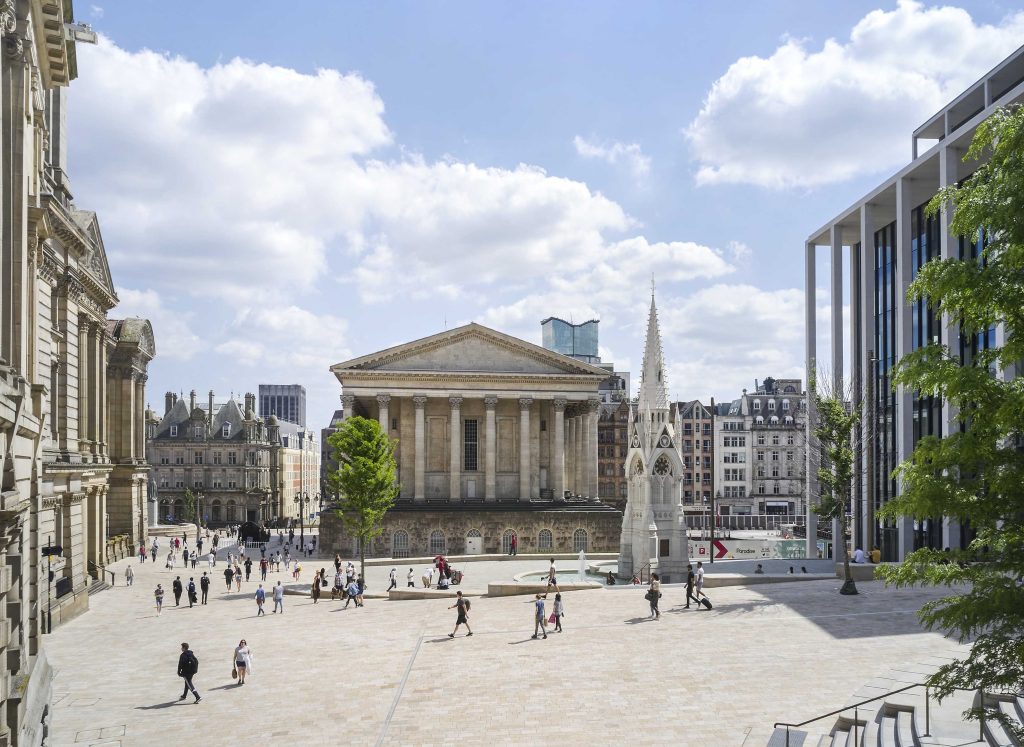
Photograph by Hufton + Crow
Paradise Masterplan Phase 1 by Glenn Howells Architects/MEPC
This is Phase 1 of the major reworking of a complex urban site in the historic and civic core of Birmingham. It aims to create a new multipurpose business, residential and leisure quarter that fits sensitively with adjacent Grade I and Grade II*-listed buildings, while creating new linking routes in the city and attracting new businesses.
Looking to reconnect the city’s existing public spaces with a new pedestrianised realm, Phase 1 involved the reworking of one of the city’s most significant squares, Chamberlain Square. It includes new landscaping, a refurbished Chamberlain Memorial Fountain and the delivery of two new flexible commercial buildings flanking it: One Chamberlain Square by Eric Parry Architects and Two Chamberlain Square, also by Glenn Howells Architects. Future phases will include a hotel, further commercial office space and build-to-rent homes constructed around two new public squares – plus the further opening-up of new connections across the city centre.
Judges praised the ‘high-quality transformation’ of the public realm and commented how the scheme ‘worked hard with the change of levels, linking two important areas of Birmingham together’, while ‘introducing a new permeability.’ One commented that ‘it makes you want to meander through’ and how ‘it is not a destination in itself but creates breakout spaces off routes’. Another said: ‘It manages a lot of moving parts well – to be congratulated, given there’s not the same level of control possible as in a building.’ It was, another summed up: ‘The connecting-up that Birmingham needed.’ RGW
Location Birmingham • Completion April 2022 • Construction cost £183 million • Client MEPC • Engineer Arup • Services engineer Arup • Main contractor BAM
School
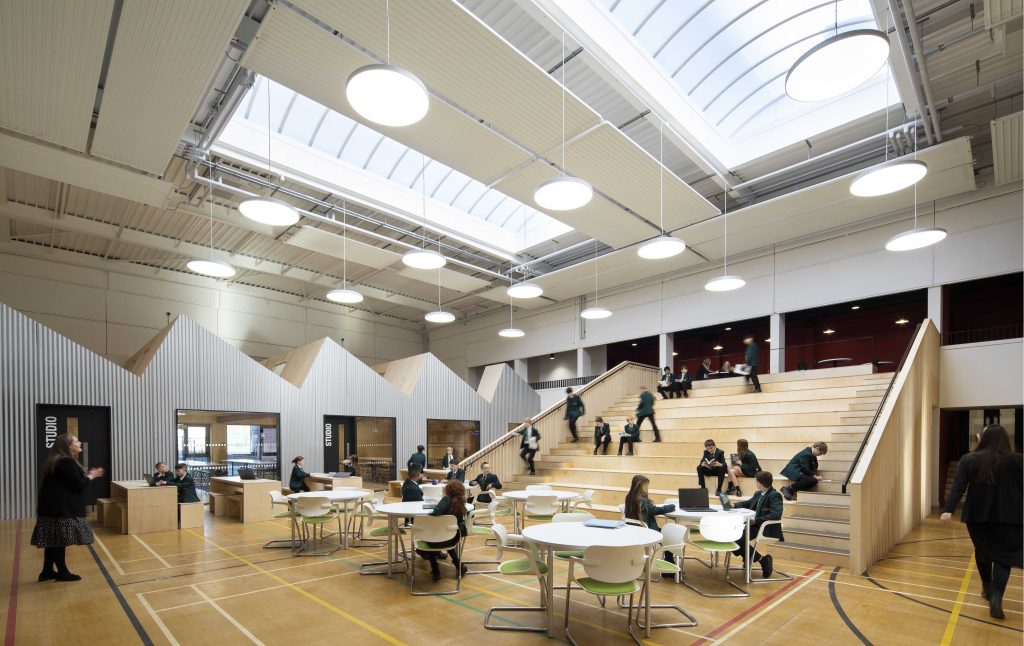
Photograph by Nick Caville
WaterSHED, Wardle Academy by BDP
‘On a tight budget, this project creates a community space in the heart of the school, and it’s making such a difference,’ said the judges of this stand-out winner.
BDP’s innovative approach to repurposing a dilapidated former school sports hall in Rochdale creates a test-bed for new forms of teaching and social learning. The new facility allows the Watergrove Trust to meet an urgent demand for school places and enables students to learn in more self-directed ways than are possible in the existing school. Two new flexible classrooms and a DT studio are oriented around a central informal learning space and café, while a processional staircase and ‘learning steps’ with integrated seating provide overflow dining space and audience seating for presentations and performances.
In direct response to the client brief, BDP’s multidisciplinary team, which included executve architect K2 Architects, took a holistic, low-carbon approach to the refurbishment, minimising alteration of the existing building fabric and maximising offsite construction, standardising panel sizes to reduce waste and using natural materials wherever possible.
Plywood, sheep’s wool insulation and acoustic wood wool panels have been used to create insulated and airtight ‘sheds’ on either side of the hall that locally improve the building performance to create a thermally efficient and comfortable environment. Existing materials such as the sports flooring have been retained and restored wherever possible and the trust obtained donated furniture from local businesses.
The completed project is a lean, sustainable and imaginative re-use of an existing asset. As the judges enthused: ‘It’s clever, simple and nicely executed. It’s a generous haven.’ EB
Location Rochdale • Completion December 2021 • Construction cost £750,000 • Gross internal floor area 850m2 • Client Watergrove Trust • Engineer BDP • Services engineer BDP • Main contractor Skyline Property Solutions • Annual carbon emissions Not supplied
Higher Education (up to £20 million)

Photograph by Joakim Borén
Duke Street Riverside by Hudson Architects
‘Tight budget – bloody good job,’ was one judge’s summary of this scheme, which provides flexible teaching spaces and student accommodation. Part of Norwich University of the Arts’ campus, it sits set back alongside the River Wensum, where it creates a new public space incorporating seating and an outdoor teaching/performance area. The building steps up from five storeys to seven alongside Duke Street, a key city thoroughfare, where the main entrance is set within an arcade. ‘It works really hard to fit in with its urban setting and to give back to the street and river,’ said one judge.
The building, which has a light-gauge steel superstructure, has a metal-clad ground floor, above which its red brick façade is animated by irregularly positioned windows, their protruding metal reveals and inset louvres providing shade.
Inside, a double-height foyer contains an informal auditorium and other facilities including a 300-seat lecture theatre, flexible teaching spaces, student lounges and staff offices – all naturally ventilated. ‘It’s a spectacular civic space and community facility,’ was one observation.
The upper storeys contain 100 en suite student rooms, arranged in self-contained clusters with communal kitchens and lounges. ‘Decent rooms and a lot of richness in the spaces,’ observed one judge. ‘I liked how the scheme brings the student accommodation and learning spaces together so they don’t undermine each other,’ added another. ‘Restrained, contained and respectful: a good, calm piece of civic architecture.’ RGW
Location Norwich • Completion October 2021 • Construction cost £15.5 million • Gross internal floor area 4,400m2 • Client Norwich University of the Arts • Engineer Rossi Long • Services engineer Max Fordham • Main contractor RG Carter • Annual carbon emissions 28.62 kgCO2/m2
Higher Education (£20 million and over)
Sponsored by VMZinc

Photograph by Nick Kane
The Marshall Building, London School of Economics and Political Science by Grafton Architects
The LSE’s most recent university building on Lincoln’s Inn Fields was praised for its timelessness, the judges describing it as ‘a building for the ages’. The 18,000m2 Marshall building sits between the formal setting of the square to the north and a more intricate urban grain to the south, carefully balancing the two conditions by adapting to its site geometry. Facing the fields, its façade becomes more open, with screens profiled to reflect sunlight, while to the south elevations are carefully modelled to balance light and shade and to create connections through its entrances, terraces, gables and the rhythm of its windows – bringing the outside in both physically and environmentally.
Formed of a post-tensioned GGBS concrete frame, the structure works hard to accommodate its range of uses through a rotating structure, developed to transfer loads from the upper levels to ever-increasing spans at ground and lower levels. Its focal point is a weave of ‘tree-like’ columns and beams directing forces to the ground through a spread of tapered diagonal ‘branches’. This creates the ‘Great Hall’, a new social space and covered piazza with sloping terrazzo floor, deemed ‘stunning’ by the judges. ‘The structure works incredibly hard in plan,’ they said.
The judges felt it was evident that the team had worked hard on all sustainability aspects by creating the most efficient concrete structure possible with exposed but ‘clean’ finishes everywhere, on what seems to be a large, solid building. They loved the beauty of the interiors and were highly impressed by how resolved the scheme was – from context and references to structure and luxury of space. FW
Location London WC2 • Completion November 2021 • Construction cost £90 million • Gross internal floor area 18,000m2 • Client London School of Economics and Political Science • Engineer AKT II • Services engineer chapmanbdsp • Main contractor Mace • Annual carbon emissions 652 kgCO2/m2
Highly commended
University of Warwick Faculty of Arts by Feilden Clegg Bradley Studios
Feilden Clegg Bradley Studios has brought together all Warwick’s arts departments under one roof for the first time in a new £43 million faculty building. Four light-filled pavilions grouped around a central stair, designed around the site’s trees, sit at the heart of a parkland campus. The judges thought the scheme was ‘worthy of note’ for its ‘pure architectural diagram’. They praised the atrium for its success in bringing the programme together. ‘It’s a clear heart to the centre of the building,’ they said. FW
Health and Wellbeing

Photograph by Ståle Eriksen
Thames Hospice by KKE Architects
Judges praised the ‘patient-centric design’ of KKE Architects’ Thames Hospice, calling it a ‘very accomplished piece of architecture’, set in a stunning landscape.
The £22 million facility, one of the UK’s largest hospices and developed by the Thames Hospice charity, was opened by the late Queen Elizabeth in July. It is situated in eight acres of landscaped gardens surrounding Bray Lake, a former gravel pit adjacent to the River Thames near Maidenhead in Berkshire.
The hospice strives to offer the highest standards of palliative and end-of-life care for thousands of patients every year. The design, which was heavily influenced by suggestions from the hospice’s doctors and nurses, is all about the wellbeing of patients, visitors and staff, breaking down the key functions of the hospice into a cluster of smaller elements reminiscent of a village.
Inside, the building avoids the stress-inducing feel of many clinical settings with a calm and co-ordinated interior made up of generous, naturally lit spaces and natural materials with accommodation for medical equipment that can be tucked away when not in use.
The AJAA judges had particular praise for the scheme’s ‘simple elegance’; for the contribution made by client Debbie Raven, the charity’s former chief executive who had previously been a nurse; and for the way in which the building connects with the lush environment outside.
‘It really felt like the landscape came into the building,’ one judge said. ‘As a former gravel pit, it’s an artificial landscape, but it’s actually a really special place.’
Another said the hospice created an atmosphere of ‘warmth, calm and hope’. WH
Location Maidenhead, Berkshire • Completion October 2021 • Construction cost £1.98 million • Gross internal floor area 5,344m2 • Client Thames Hospice • Engineer Price & Myers • Services engineer Price & Myers • Main contractor Andrew Scott • Annual carbon emissions Not supplied
Mixed-use
Sponsored by Cembrit
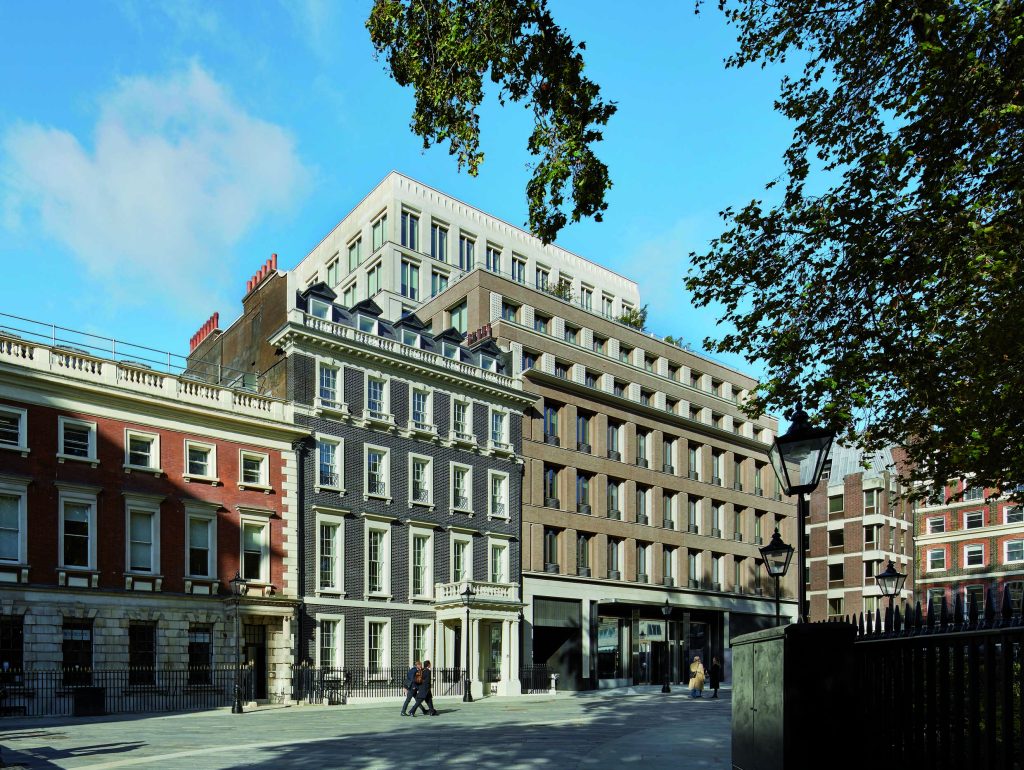
Photograph by Paul Riddle
Hanover by Lifschutz Davidson Sandilands
In a tightly fought category in which two very different projects stood out, the judges opted for Lifschutz Davidson Sandilands’ ambitious scheme, praising it as ‘complex and very successful’. It provides about 30,000m2 of offices, shops, restaurants and apartments in new structures behind retained frontages and in restored listed buildings.
Much of the new space has been built over the eastern entrance and ticket hall of Bond Street Crossrail station. New structures include a nine-storey office building, while on New Bond Street/Brook Street shops and upper-level offices sit behind one new frontage and eight carefully retained façades. A fully restored Grade ll*-listed building, 20 Hanover Square, is now occupied by a fashion academy and designer/maker studios above a ground-floor and basement restaurant.
A key move was to persuade Crossrail to move station ventilation shafts, allowing pedestrian routes through the previously impermeable site along a new arcade and landscaped piazza from New Bond Street to Hanover Square, and another south from Dering Street to the development’s interior. The new retail arcade extends from a courtyard entrance under a granite arch at 68 New Bond Street into a colonnaded walkway of shops and restaurants that line the north side of a new public space, Medici Courtyard, into Hanover Square.
The judges said: ‘The heritage elements are incredible, and the new components fit really well. It is successful mixed-use, to a demanding brief, and feels comfortable as part of the urban realm. There is real skill in pulling this all together – every challenge they came across, they dealt with very well.’ EB
Location London W1 • Completion January 2022 • Construction cost £180 million • Gross internal floor area 30,000m2 • Client GPE • Engineer WSP Group • Services engineer Hilson Moran Partnership • Main contractor MACE • Annual carbon emissions Not supplied
Highly commended
The Cabins by Neat Architects
The judges were fulsome in their praise of this scheme: ‘Forward-thinking’, ‘done with care’, with an ‘exceptional’ client. Located on a complex site in a densely built-up urban environment, this cluster of mixed-use timber framed buildings in the heart of Folkestone’s Old Town supports creative industries by providing affordable, innovative spaces for studios, workshops and homes. ‘This is the way we should be thinking about development,’ added the judges. ‘It’s not overdeveloped. It’s embedded in place and is very sensitive to its community. It is doing what needs to be done. They’ve done a fantastic job.’ EB
Infrastructure and Transport

Photograph by Gareth Gardner
Battersea Power Station (London Underground) by Grimshaw
Used by tens of thousands of people daily, the Northern Line extension is a major addition to the London Underground network. Running from Kennington to Battersea Power Station, the 3.2 km extension connects the Vauxhall, Nine Elms and Battersea regeneration area in south-west London with the rest of the capital. Two new Underground stations, Nine Elms and Battersea Power Station, form the key elements of the extension, with two new head houses enclosing ventilation shafts located in Kennington.
The best kind of transport infrastructure facilitates and civilises the ordinary experience of daily travel. The judges were impressed by the spatial and material quality of the two new Underground stations as beacons and anchoring points in still-evolving urban landscapes. The station entrance canopy was singled out for special praise, while the head houses had a quiet, functional dignity that belied the complexity of their engineering.
Within each new station, care has evidently been taken to streamline passenger flow, with legible wayfinding and natural light introduced where possible. There were also moments designed to further lift the spirit: a kinetic installation by Alexandre da Cunha animates the entire length of the station ticket hall, part of TfL’s ‘Art on the Underground’ programme.
Overall, the architecture was designed to minimise maintenance, with a whole-life cost approach underscoring the choice of cladding materials, which are self-finishing, robust and durable. Reducing the thickness of the segments lining the tunnel walls from 280mm to 250mm also generated considerable savings, both in the volume of concrete used and the associated carbon emissions. CS
Location Battersea • Completion September 2021 • Construction cost £1.26 million • Gross internal floor area N/A • Client Transport for London • Engineer Mott MacDonald • Main contractor Ferrovial Agroman, Laing O’Rourke (joint venture) • Annual carbon emissions 34,200 tonnes CO2
Highly commended
Espérance Bridge by Moxon Architects
Designed to traverse the Regent’s Canal and create a more direct pedestrian route into Coal Drops Yard, the sculptural form and bold colour of Espérance Bridge caught the jury’s eye. The folded plate truss echoes the form of an old railway bridge which occupied this exact location and shows that public infrastructure can be visually compelling. The only caveat was its proximity to existing bridges – was it really necessary? asked the judges. Nonetheless, it was agreed that it was a stylish and accomplished project that added to the architectural richness of its locale. CS
Workplace (up to £10 million)
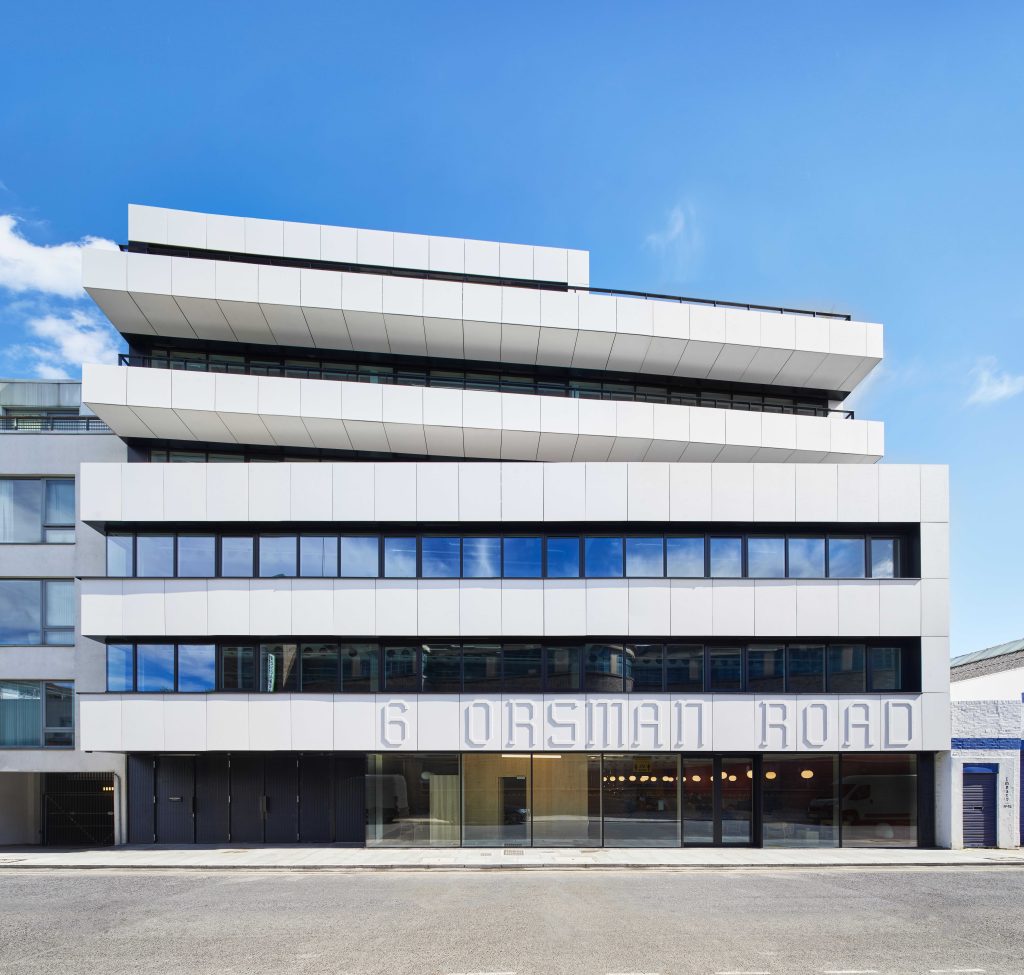
Photograph by Ed Reeve
6 Orsman Road by Waugh Thistleton
‘This office is in a bit of an in-between location,’ observed the judges. ‘Haggerston is hardly the centre of town.’ Nevertheless, its fill of occupants – including an architecture practice and an architecture school – is testament to the quality of its environment. ‘It has a real sensibility to it,’ said the judges, who noted that the acoustics are good, the circulation space is roomy and there is a real buzz about the building. Communal areas are likewise generous, with slick finishes and a striking colour palette, which judges described as ‘luxurious’, despite simultaneously being ‘pretty basic’. Workers on every floor had nice things to say about their workplace.
This building is very much more than meets the eye. The structure is predominantly cross-laminated timber, with some steel, while many of the finishes are also timber: more or less the only construction material to sequester carbon.
Judges said the building had an authentic strategy around circular economy, the whole designed to be a ‘materials bank’ for the future. They added that the architect had challenged the client about the scope of the work. And they were deeply impressed that, when the developer decided they wanted a staircase, Waugh Thistleton came up with a solution which involved cutting holes in CLT floorplates and using the off-cuts to create the stairs.
‘We’re not inundated with projects that address the climate emergency like this project does,’ said one judge, adding: ‘In terms of workplace, and being in it as a place, and in its buildable approach, it is doing so much.’ WI
Location London N1 • Completion June 2021 • Construction cost £9.5 million • Gross internal floor area 5,085m2 • Client Boultbee Brooks, Storey British Land • Engineers GDC Partnership, Engenuiti, Ramboll • Services engineer Mendick Waring, Ramboll (fit-out) • Main contractor RFM Construction Management, Parkeray • Annual carbon emissions 14.6 kgCO2/m2
Workplace (£10 million and over)

Photograph by Tim Soar
The Bailey by Orms
This refurbishment and extension of a Grade II-listed Edwardian office building and its 1999 extension in Holborn, central London, was praised by judges for the ‘real care and clarity of thinking’ in its approach to retrofit, as well as the ‘consistency of the environmental thinking’ and ‘beautiful use and detailing of materials’.
The building was extensively remodelled internally and the floor area increased by 2,100m2 through adding two floors and filling in a redundant atrium, as well as relocating the main lift and stair core centrally within the plan, unifying the office wings into a simpler floor plate. Externally, nine landscaped terraces have also been added.
Judges praised how the scheme made ‘good, intelligent moves’ yet was ‘not desperate to make a statement at each step’ and commented on the ‘sensitive and careful fixing’ of the existing fabric. ‘The reworked core and interiors are exquisite,’ said one. In particular, they praised the decision to retain the 1990s curtain wall façade as ‘not sexy, but bold and brave’. ‘It’s easy to teach the value of an Edwardian listed building but talking clients into keeping a 1990s glass box is quite another,’ commented one, adding: ‘It is the kind of thing we should be persuading clients to retain.’
The judges also commended the presentation of the project by the two architects, who ‘offered a real clarity of thought throughout.’ One judge summarised: ‘Everything has been handled with great skill and care across the whole of the building.’ RGW
Location London EC4 • Completion March 2021 • Construction cost Undisclosed • Gross internal floor area 14,564m2 • Client Endurance Land • Engineer Heyne Tillett Steel • Services engineer GDM Partnership • Main contractor Knight Harwood • Annual carbon emissions 17.6 kgCO2/m2
Housing
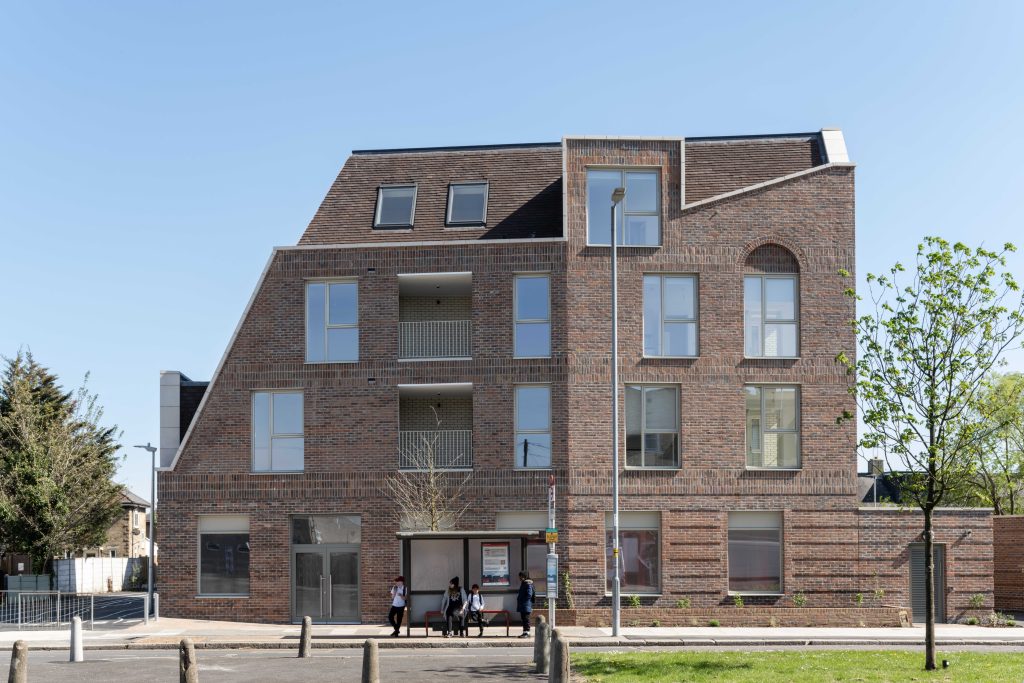
Photograph by FRENCH+TYE
200 Becontree Avenue by Archio
‘A scheme full of enthusiasm and energy, with bags of whimsy and generosity’, said the judges about Archio’s 200 Becontree Avenue affordable housing project in Dagenham. The 19-apartment development for Barking and Dagenham Council’s in-house regeneration company, Be First, was picked ahead of an impressive shortlist.
Archio’s two-villa project sits on a former synagogue site within the famous east London estate created in the 1920s for returning First World War combatants under the Homes Fit for Heroes pledge. It remains the largest public housing scheme in the world, with 26,000 homes.
The design reflects and ‘playfully interprets’ the Neo-Georgian architecture of nearby houses, with exaggerated dormers, undulating eaves lines, semi-circular arches and round windows.
All the flats are triple-aspect and, according to the AJ 40 under 40 practice, feature ‘high-performing building fabric, close to Passivhaus [standard]’, together with underfloor heating powered by air source heat pumps.
The judges described the ‘inspiring’ 1,865m2 infill scheme as a ‘highly contextual response to its site’ that pointed to an exciting future direction for housing in Dagenham. They added: ‘The practice has taken the client on a journey to deliver something successfully different. Together they have made homes for people, not just homes. From the small details to the big moves, 200 Becontree Avenue is full of joy. It brought a smile to our faces.’ RW
Location London RM8 • Completion March 2022 • Construction cost £5 million • Gross internal floor area 1,865m2 • Client Be First • Engineer Wilde • Services engineer Butler and Young, SMCS • Main contractor United Living • Annual carbon emissions Not supplied
The AJ Architecture Awards are supported by:
